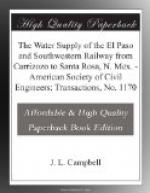Each piece of pipe goes directly from the winder to the asphalt rolls, then to an adjacent saw-dust table, then back to the rolls, then to the table again, and then to the dry finishing rolls at the opposite end of the table. The coating thus consists of two layers of asphalt and two of saw-dust. When the pipe leaves the finishing rolls, the coat is hard and smooth and about 1 3/16 in. thick. This describes the coating as done at Bay City, Mich.
At Elmira, N.Y., one application of asphalt and saw-dust only, without a finishing dry roll, completed the work; but the band was run through a bath of hot asphalt as it was wound, thus coating its underside also. This initial treatment of the band on the Wykoff pipe is necessary because the exterior of the stave is neither planed nor turned to a circle. The exterior of the pipe forms a polygon, and the band is in perfect contact only at the angles. The theory in regard to the Michigan pipe is that the perfect contact of the band and the wood on the true exterior circle excludes air from the under surface of the metal, and prevents corrosion. Experience appears to justify this theory.
Cast-iron Pipe.—Beginning at the first pumping plant at Coyote, at Mile 156, and running up to Mile 166, and again commencing at the Luna pumps, at Mile 171, and extending up to Mile 179, the minimum pressure on those portions of the pump main is more than the 130 lb. per sq. in. allowed for wood pipe, and the final estimated maximum pressures run up to 310 lb.
The selection of iron pipe for these pressures was, first, as between steel and cast-iron; and, second, as between the lead joint of the standard bell and spigot pipe and the machined iron joint of the universal joint pipe. Again, the choice was as between lead and leadite for the bell and spigot pipe.
Cast iron was selected because of the certainty of its long life, and the bell and spigot pipe was selected on the basis of comparative costs for pipe laid. The standard lead joint was chosen on the result of tests. This cast-iron pumping main has a diameter of 12 in. throughout.
Pipe Weights.—Makers of standard bell and spigot pipe urged the usual heavy weights selected for municipal service and heavy water-hammer. Three pressures, viz., 217, 260, and 304 lb., were used for the division of pipe weights, on which the standard pipe-makers specified shell thicknesses of 0.82, 0.89, and 0.97 in. Eliminating water-hammer and adopting a working stress of 2,400 lb., the thicknesses are reduced to 0.54, 0.65, and 0.76 in. To make the latter conform to the specifications of the New England Water-Works Association, the pipe was cast to 0.57, 0.65, and 0.77 in. The reduction in cost amounts to $52,811.
By the provision of air-cushions, hereafter described, the writer’s anticipation of no water-hammer on the pumping main has been fully realized.
The pipe was manufactured and inspected under the above-mentioned specifications.




